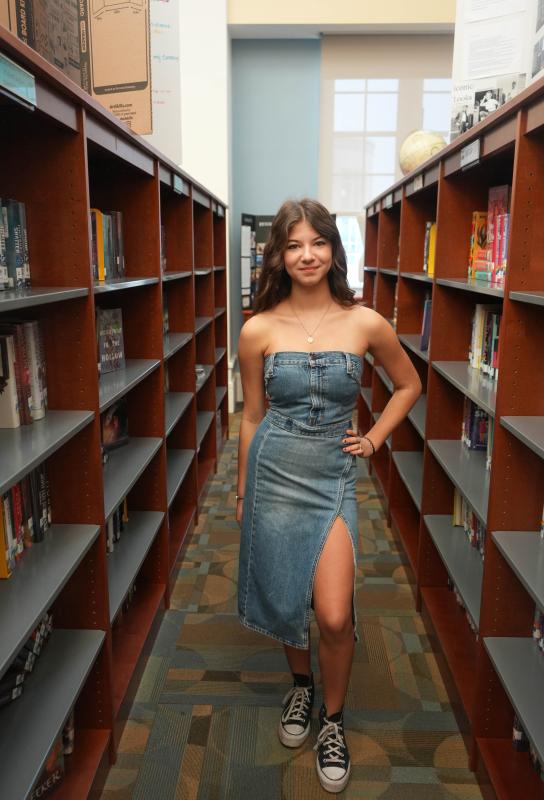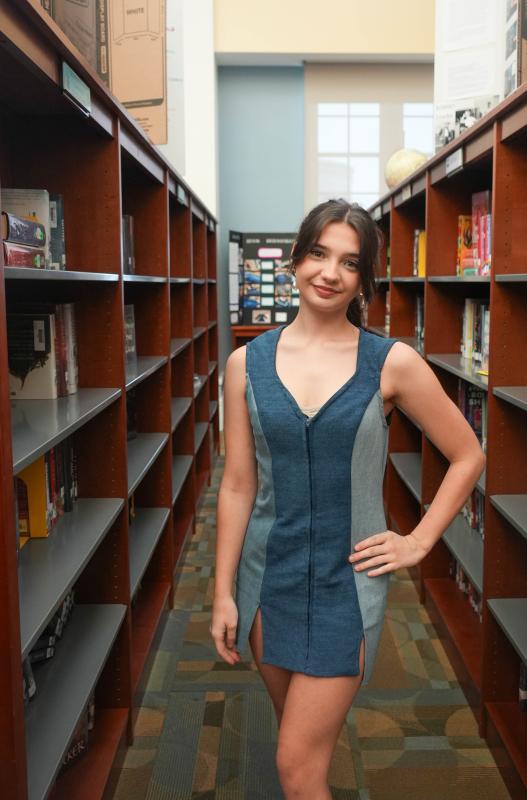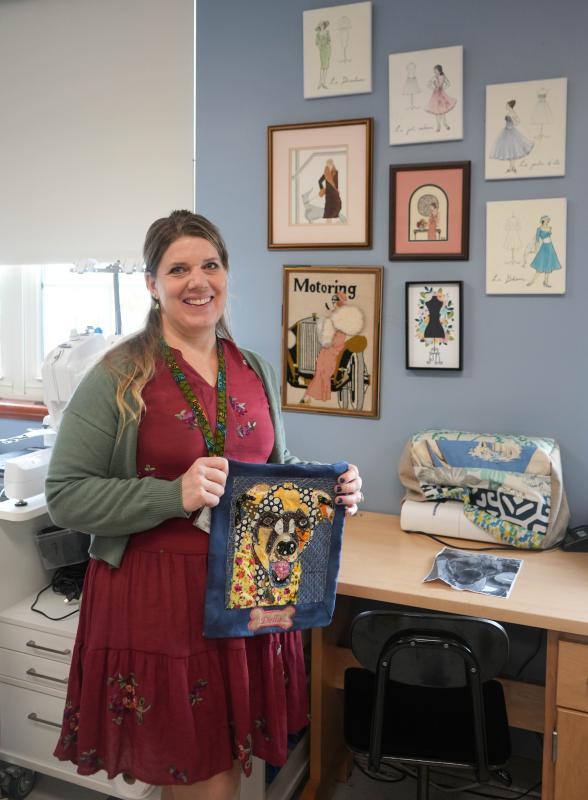Cape High shows off denim upcycling
Denim jackets, bags, corsets and dresses hang atop the Cape High library shelves, a culmination of nine weeks of student creativity and hard work.
The denim upcycle projects, created by students in the school’s Fashion Construction and Design program, are on display in the library through the end of November.
According to program teacher Alayna Aiken, the project, which aimed to challenge students to create new, unique pieces out of recycled materials, was a blast.
“I’m not [an] intense, high-fashion person,” said Aiken, who’s taught at Cape High for 13 years. “I’m like, let’s figure out how to make it and save money.”
The students began their nine-week projects by researching and planning out their designs, taking inspiration from fashion designers and brands of their choice. Then, they started the deconstruction process, reworking about 75 pairs of jeans donated by Cape High librarian Debbie Supplee from a “thrift shop” she managed from the library for kids in need.
Sarai Vivar-Lucero, 15, who created a denim handbag similar to the first bag she received for her birthday, a Coach purse, has loved fashion since she was little, when she and her sister would make dresses out of trash bags.
She began sketching clothing in middle school and started taking sewing classes in high school. She hopes to one day become a fashion designer.
“I just felt like myself when I would create something,” she said.
For her denim upcycling project, she took inspiration from denim brand True Religion, incorporating bright red embroidered stitching. She added a magnetic flap to open and close the bag.
Another student, junior Ryleigh Moyer, designed her project with inspiration from fashion designer Stella McCartney, whose main thing, Moyer said, is ruffles, sequins and bedazzling.
She created a calf-length dress with a strapless bodice and thigh-high slit. She used one pair of jeans to create the bodice and skirt, and then another pair for the waist and the loops at the top of the dress.
She originally planned to incorporate ruffles on the top and bottom hems and add bedazzling, but she said she didn’t have the resources to do so.
“That didn’t work out, so I was like, I’ll just turn it into my own thing,” she said.
Figuring out the zipper was a process, Moyer said, and the first zipper she used completely snapped when she zipped it up.
“I was so heartbroken,” she said.
She then had to find another, more durable zipper to use.
According to Aiken, one of the biggest challenges for the students was that the denim had already been cut into pairs of jeans, so there weren’t any whole pieces of fabric for them to use, and they had to work around the seams.
“You’ve got to figure out, do I want the seam to show?” Aiken said. “Do I want to hide it? Do I want it to be more pronounced? It was just figuring out what to do with what we had to work with.”
Junior McKenzie Everson’s project, a strapless corset, for example, features a seam down the front center of the garment.
“We did that because of the shape of the leg [of the jeans], [which] made it really challenging,” Aiken said. “So her whole project is askew, but we figured out how to make it not look that way.”
The students also had to learn to accept the changes that occurred during the design process, which sometimes meant a complete change of direction in their designs, Aiken said. They kept photo journals of their projects from start to finish to record the process.
The project taught the students to be resourceful and challenged them to use their imagination to give new life to pre-loved pieces of clothing.
“Creativity is the highest order of thinking,” Aiken said. “When kids are creating, they’re engaged in what they’re doing. They’re expressing themselves, and it’s showing off the highest level of [human] intelligence. That’s my favorite part of it, watching their brains churn.”



Ellen McIntyre is a reporter covering education and all things Dewey Beach. She graduated with a bachelor’s degree in journalism from Penn State - Schreyer Honors College in May 2024, then completed an internship writing for the Pittsburgh Post-Gazette. In 2023, she covered the Women’s World Cup in New Zealand as a freelancer for the Associated Press and saw her work published by outlets including The Washington Post and Fox Sports. Her variety of reporting experience covers crime and courts, investigations, politics and the arts. As a Hockessin, Delaware native, Ellen is happy to be back in her home state, though she enjoys traveling and learning about new cultures. She also loves live music, reading, hiking and spending time in nature.























































